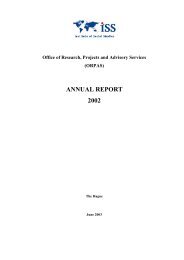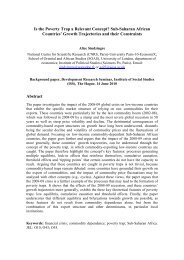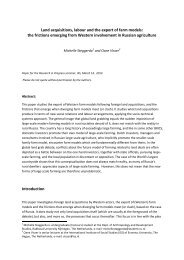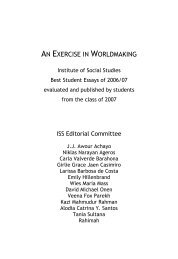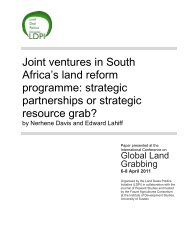AN EXERCISE IN WORLDMAKING 2009 - ISS
AN EXERCISE IN WORLDMAKING 2009 - ISS
AN EXERCISE IN WORLDMAKING 2009 - ISS
Create successful ePaper yourself
Turn your PDF publications into a flip-book with our unique Google optimized e-Paper software.
7 Does the Aid Consensus Shift from Washington to the South? 73<br />
maps the criticisms that have been expressed on the principle of ownership<br />
in relation to the PRSP process. Fourthly, the theoretical background<br />
of the presumed paradigm shifts after the Washington Consensus<br />
will be examined. The Latent South Consensus described here will<br />
provide a tool to measure alternative policies that indicate the scope for<br />
ownership. The analysis of Rwanda’s EDPRSP 2008-2012 in the fifth<br />
section will reveal the scope for alternative policies reflecting ownership.<br />
The findings will be summarised in the conclusion.<br />
2 CH<strong>AN</strong>G<strong>IN</strong>G THE ARCHITECTURE OF AID<br />
After the decolonisation, the first official development aid flowed to the<br />
Global South under the assumption that these countries only suffered an<br />
investment gap, and thus a big push was needed to get them back on<br />
track. Although the “dirigist” local post-colonial development policies<br />
can be commended for some achievements, they were heavily criticised<br />
by the donor community in the 1970s for their weak results (Meyer and<br />
Schulz 2008: 2).<br />
The weak state systems were blamed for their inefficient interventions<br />
in the economy – announcing of the rise of neoliberalism. In the following<br />
decades, the IFIs and the OECD donor countries worked together<br />
towards the downsizing of the development state. Macroeconomic<br />
stability was prioritised as a means for development under the Structural<br />
Adjustment Programmes (SAP). In the 1980s, the IFIs coupled this<br />
to the principle of conditionality. That is, a country should comply with<br />
the SAP first before receiving development aid. Conditionalities can be<br />
seen as the first vehicle for improving aid effectiveness, but they came at<br />
a high cost: they were criticised for excluding the (poor) people in developing<br />
countries whose governments did not comply with SAPs.<br />
As history shows, the SAPs did not bring about miracles either. The<br />
assumed relationship between macroeconomic stability, liberalisation and<br />
growth proved to be weak in practice. Many developing countries endured<br />
growing poverty, inequality and debt (McKinley 2008: 93). The<br />
IFIs were criticised for the failure of their policy prescriptions.<br />
The New Aid Architecture<br />
In the 1990s the IFIs were seen as the bloodletting doctors of the 19th<br />
century, whose prescriptions only make the patient weaker. The aid fa-




